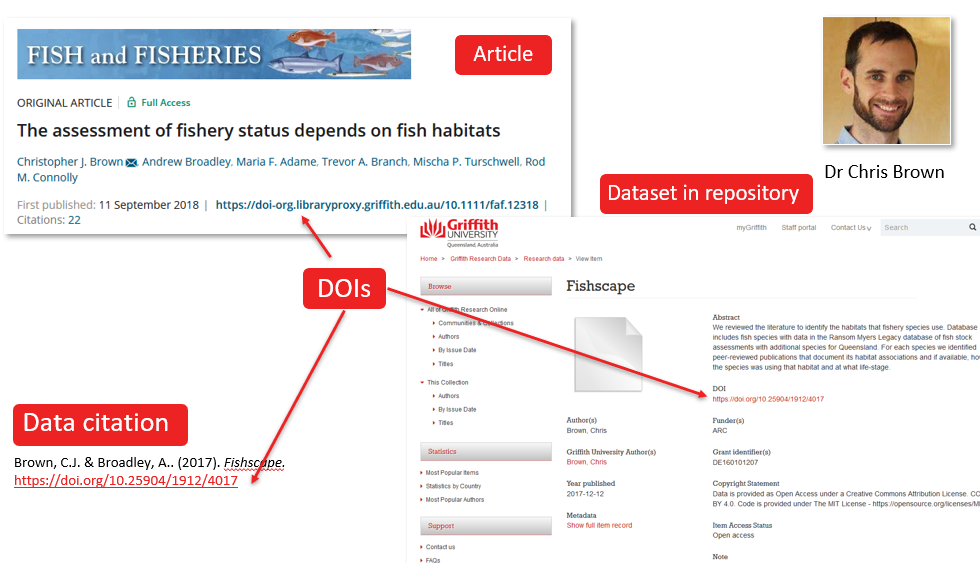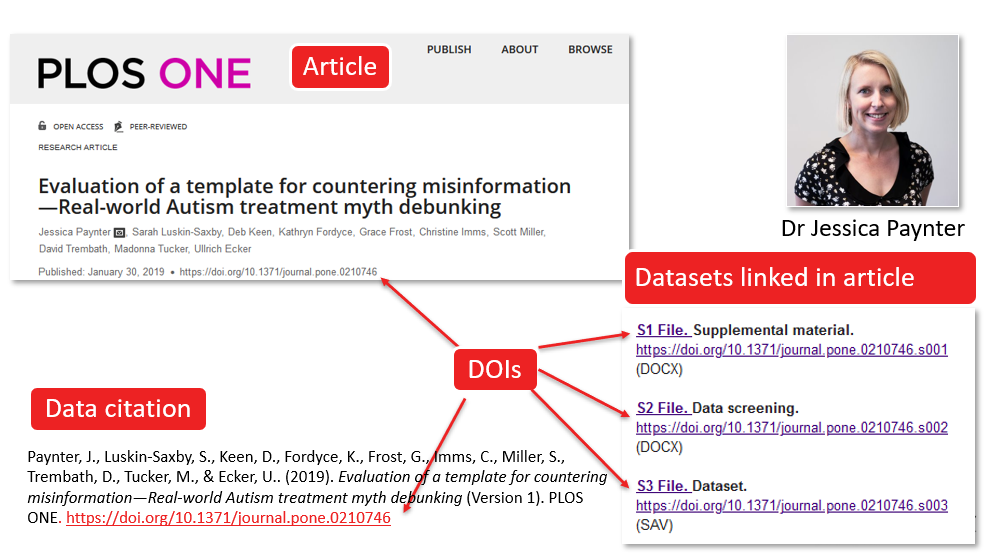10 - Publish Data with Persistent Identifiers

Scenario: Someone has published contradicting results to your published paper.Can your provide your data and methods?
At the end of your project, make your research data Findable, Accessible, Interoperable and Re-useable (F.A.I.R) and ultimately reproducible, by publishing it with a Persistant Identifier (PiD) such as a Digital Object Identifier (DOI).
How?
Deposit final state data to support your publications in an institutional or discipline data repository which can mint a DOI and create a citation for your work.
- Examples include:
- Griffith Research Online (GRO) Data Repository
- Figshare
- Zenodo particularly useful for research code hosted in Github
- Australian Data Archive for large or longitudinal social science datasets
- re3data.org good list of discipline repositories
- PLoS journals recommended repositories
What is the difference?
- An identifier is any label used to name an item (whether digital or physical). URLs and serial numbers are an examples of digital identifiers. Personal names are also identifiers, but are not necessarily unique as you may share the same name with other researchers around the world.
- A persistent identifier is long-lasting unique digital reference to a webpage, digital object, even a person.
| Identifiers | Persistent Identifiers |
|---|---|
| examples… | |
| your name, urls, serial numbers | Open Researcher and Contributor ID (ORCID), Digital Object Identifiers (DOI) |
| management over time… | |
| links disappear | links are kept up to date over a defined time period |
| websites shut down | links will find the object, even when websites change |
| product support ends | management guaranteed |
A Digital Object Identifier (DOI) is a unique alphanumeric string that:
- is assigned by either a publisher, organisation or agency
- identifies content
- provides a persistent link to its location or record on the internet and links to other related research output
- facilitates citation and citation metrics
A DOI example: http://dx.doi.org/10.4225/01/4F8E15A1B4D89
One persistent identifier example: https://research-repository.griffith.edu.au/handle/10072/394379, from Griffiths’ Research Data Repository.
DOIs uniquely identify research data and support citation and citation metrics.
Watch this short video from Research Data Netherlands explaining Persistant identifiers and data citation (4:52)
Key messages:
- DOIs are the globally accepted identification standard for digital scholarly publications, detailing the necessary metadata to support credit and attribution.
- DOIs can be created for datasets and associated outputs (e.g. grey literature, workflows, algorithms, software etc.) - DOIs for data are equivalent to DOIs for other scholarly publications
- DOIs enable accurate data citation and bibliometrics (both metrics and altmetrics)
- Resolvable DOIs provide easy online access to research data for discovery, attribution and reuse
- Dataset DOIs can be linked using standard metadata schemas to other research output, increasing opportunities to reproduce research.
The examples below show how DOIs connect scholarly publications with supporting datasets.

Chris’s dataset is a large collecttion which has been analysed for multiple projects and articles. The dataset is available for validation of his work and also reuse by other researchers, with a citation and DOI created by GRO. Chris also shares the supporting code via Github.
- Data Citation: Brown, C.J. & Broadley, A.. (2017). Fishscape. https://doi.org/10.25904/1912/4017
- Article Citation: Brown, C. J., Broadley, A., Adame, M. F., Branch, T. A., Turschwell, M. P., & Connolly, R. M. (2019). The assessment of fishery status depends on fish habitats. Fish and Fisheries, 20(1), 1-14. https://doi.org/10.1111/faf.12318

Jessica’s research was published in a journal which could also publish and mint a DOI for her supporting dataset.
- Data and Article Citation: Paynter, J., Luskin-Saxby, S., Keen, D., Fordyce, K., Frost, G., Imms, C., Miller, S., Trembath, D., Tucker, M., & Ecker, U.. (2019). Evaluation of a template for countering misinformation—Real-world Autism treatment myth debunking (Version 1). PLOS ONE. https://doi.org/10.1371/journal.pone.0210746
- Publish your final state data in a repository which will mint a DOI for you, see the repository links above.
- Cite your dataset in the references of the articles it supports. This is the best way for others to find and access your dataset, for reproducibility purposes or to use with attribution in their own research. Professor Mark Finnane illustrates this in the citation to his dataset The Prosecution Project Database in reference 27 of his article published in the UNSW Law Journal.
- Contact your Library staff for guidance.
- Learn more about how DOIs and their use in data citations enables tracking and quantitative measuring of publication impact and data impact. from Honor et. al.
- Read the ARDC Data & Software Citation Guide.
- Learn more about the ARDC’s policy supporting PiDs to improve tracking of research impact, contribute to research integrity and enable research innovation.
- Read the article Ten simple rules for getting and giving credit for data or Ten simple rules for improving research data discovery for researcher perspectives on linking data to publications.
Internal Resources
- Contact the Library Repository Team via the online form for advice on how to obtain a DOI for your data upon project completion.
External Resources
- ARDC Data & Software Citation Guide
- Honor, L. B., Haselgrove, C., Frazier, J. A., & Kennedy, D. N. (2016). Data citation in neuroimaging: Proposed best practices for data identification and attribution. Frontiers in neuroinformatics, 10, 34. https://doi.org/10.3389/fninf.2016.00034